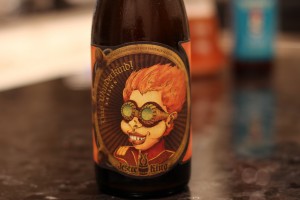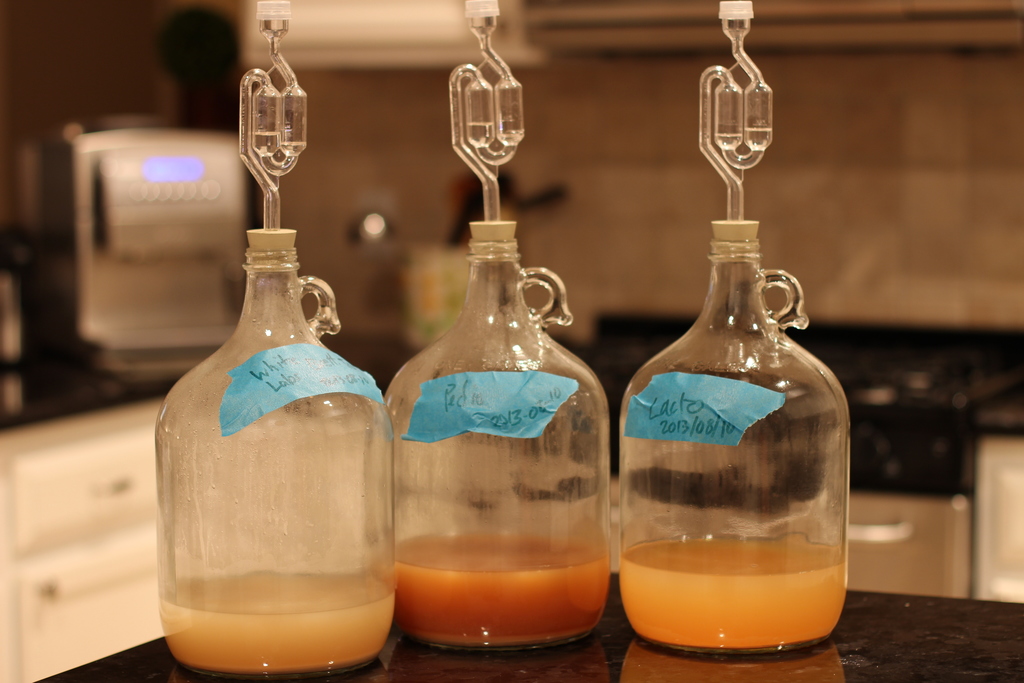
Das Wunderkind – Saison from Jester King Brewery
During the hot summer months of Texas I really get into crisp, clean, dry beers. My craft beer pallet has been shifting, and I’m definitely enjoying beers that have a lower finishing gravity than higher. I’m a member of the Rare Beer Club which sends two exceptional beers once a month and even with such exceptionally good beers, there are quite a few that I must share since I cannot drink more than a sample; the sweetness of some of the Belgians overwhelm my tastes.
I suppose then it’s a good thing that I have a fantastic source of dry, sour beers so close to Austin, Texas. Out at the Jester King Brewery, of which I am a huge fan, they have a wide selection of amazing beers. With the recent changes in the arcane Texas Beer laws it’s now much easier to sample and obtain the great beers that are brewed and aged out at that farmhouse brewery.

Brett Drie sample from Jester King
When I volunteered for bottling day at Jester King a few months ago one of the bits of information I picked up was the use of Brettanomyces for bottling yeast. I had been reviewing a really exciting thread on Homebrewtalk about using Brett Drie, the strain isolated from Fantôme brewery in Belgium. I immediately recognized the name and the flavor profile that it had be contributing to the aged bottles of Jester King. Jeff Stuffings, the head brewer at Jester King, graciously agreed to share a sample of their Brett Drie so I could make use of it.
I couldn’t think of a better way to test it out other than to brew up my interpretation of their Das Wunderkind saison. Recently they’ve been blending their aged sour beer back into their young beers, effectively creating new beers with resounding success. For this recipe I wanted to attempt the same thing. Thus, here I am with 11 gallons of saison and plans to ferment half of it with just French Saison Yeast (Wyeast 3711) and then to blend it with the other half that will sit on oak cubes, brett and souring bacteria.
The original plan was to use my 5 gallon barrel that now has been patched with barrel wax. However, since it’s had lots of time to sit with water in it I’m not entirely confident that I’ve removed the mold that may have developed before I found out that I should be using “holding solution”, a combination of potassium metibasulphate and some citric acid.

Brett B. Trio, Pedio, and Lacto starters
In the barrel’s stead, I’ll pitch in 1.5 oz of french oak cubes along with an array of souring organisms while the saison ages. In a few months, I’ll start the blending process. If this process is successful, then I’ll brew another batch of this recipe and pitch the young beer into the carboy and let it ferment with the old, sour beer.
My interpretation of Das Wunderkind.
Recipe Details
| Batch Size |
Boil Time |
IBU |
SRM |
Est. OG |
Est. FG |
ABV |
| 11 gal |
90 min |
24.7 IBUs |
5.3 SRM |
1.041 |
1.004 |
4.7 % |
|
Actuals |
1.047 |
1.006 |
5.4 % |
Style Details
| Name |
Cat. |
OG Range |
FG Range |
IBU |
SRM |
Carb |
ABV |
| Saison |
16 C |
1.048 - 1.065 |
1.002 - 1.012 |
20 - 35 |
5 - 14 |
2.3 - 2.9 |
5 - 7 % |
Fermentables
| Name |
Amount |
% |
| Pilsner (2 Row) Bel |
11.938 lbs |
68.26 |
| Brewer's Malt, 2-Row, Premium (Great Western) |
2.388 lbs |
13.65 |
| Wheat Malt, Ger |
1.273 lbs |
7.28 |
| Oats, Flaked |
1.1 lbs |
6.29 |
| Caramunich I (Weyermann) |
12.65 oz |
4.52 |
Hops
| Name |
Amount |
Time |
Use |
Form |
Alpha % |
| Goldings, East Kent (2011 Crop - Purchase FHBW 20130220) |
1.66 oz |
60 min |
Boil |
Pellet |
5.6 |
| Saaz |
1.1 oz |
15 min |
Boil |
Pellet |
7.6 |
| Cascade (2012 - Nikobrew 2012-11-23) |
2.2 oz |
7 days |
Dry Hop |
Pellet |
5.9 |
| Columbus (Tomahawk) - 2012 Crop - Purchased 20130220 |
1.1 oz |
7 days |
Dry Hop |
Pellet |
15.3 |
Miscs
| Name |
Amount |
Time |
Use |
Type |
| Calcium Chloride |
2.30 g |
60 min |
Mash |
Water Agent |
| Gypsum (Calcium Sulfate) |
2.30 g |
60 min |
Mash |
Water Agent |
| Epsom Salt (MgSO4) |
0.30 g |
60 min |
Mash |
Water Agent |
| Yeast Nutrient |
2.00 tsp |
5 min |
Boil |
Other |
Yeast
| Name |
Lab |
Attenuation |
Temperature |
| Belgian Saison (3724) |
Wyeast Labs |
87% |
70°F - 95°F |
| Brettanomyces Bruxellensis Troi (WLP644) |
White Labs |
70% |
65°F - 72°F |
| Lactobacillus Bacteria (WLP677) |
White Labs |
70% |
65°F - 72°F |
| Pediococcus Cerevisiae (4733) |
Wyeast Labs |
67% |
60°F - 95°F |
Mash
| Step |
Temperature |
Time |
| Mash In |
152°F |
60 min |




